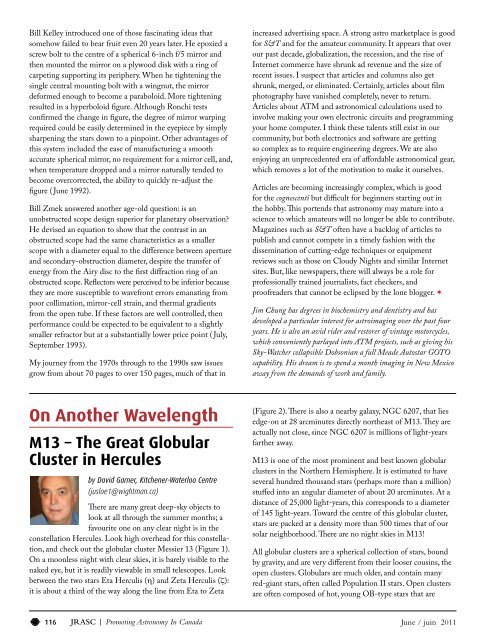The Running Man Nebula
The Running Man Nebula - The Royal Astronomical Society of ...
The Running Man Nebula - The Royal Astronomical Society of ...
You also want an ePaper? Increase the reach of your titles
YUMPU automatically turns print PDFs into web optimized ePapers that Google loves.
Bill Kelley introduced one of those fascinating ideas thatsomehow failed to bear fruit even 20 years later. He epoxied ascrew bolt to the centre of a spherical 6-inch f/5 mirror andthen mounted the mirror on a plywood disk with a ring ofcarpeting supporting its periphery. When he tightening thesingle central mounting bolt with a wingnut, the mirrordeformed enough to become a paraboloid. More tighteningresulted in a hyperboloid figure. Although Ronchi testsconfirmed the change in figure, the degree of mirror warpingrequired could be easily determined in the eyepiece by simplysharpening the stars down to a pinpoint. Other advantages ofthis system included the ease of manufacturing a smoothaccurate spherical mirror, no requirement for a mirror cell, and,when temperature dropped and a mirror naturally tended tobecome overcorrected, the ability to quickly re-adjust thefigure ( June 1992).Bill Zmek answered another age-old question: is anunobstructed scope design superior for planetary observation?He devised an equation to show that the contrast in anobstructed scope had the same characteristics as a smallerscope with a diameter equal to the difference between apertureand secondary-obstruction diameter, despite the transfer ofenergy from the Airy disc to the first diffraction ring of anobstructed scope. Reflectors were perceived to be inferior becausethey are more susceptible to wavefront errors emanating frompoor collimation, mirror-cell strain, and thermal gradientsfrom the open tube. If these factors are well controlled, thenperformance could be expected to be equivalent to a slightlysmaller refractor but at a substantially lower price point ( July,September 1993).My journey from the 1970s through to the 1990s saw issuesgrow from about 70 pages to over 150 pages, much of that inincreased advertising space. A strong astro marketplace is goodfor S&T and for the amateur community. It appears that overour past decade, globalization, the recession, and the rise ofInternet commerce have shrunk ad revenue and the size ofrecent issues. I suspect that articles and columns also getshrunk, merged, or eliminated. Certainly, articles about filmphotography have vanished completely, never to return.Articles about ATM and astronomical calculations used toinvolve making your own electronic circuits and programmingyour home computer. I think these talents still exist in ourcommunity, but both electronics and software are gettingso complex as to require engineering degrees. We are alsoenjoying an unprecedented era of affordable astronomical gear,which removes a lot of the motivation to make it ourselves.Articles are becoming increasingly complex, which is goodfor the cognescenti but difficult for beginners starting out inthe hobby. This portends that astronomy may mature into ascience to which amateurs will no longer be able to contribute.Magazines such as S&T often have a backlog of articles topublish and cannot compete in a timely fashion with thedissemination of cutting-edge techniques or equipmentreviews such as those on Cloudy Nights and similar Internetsites. But, like newspapers, there will always be a role forprofessionally trained journalists, fact checkers, andproofreaders that cannot be eclipsed by the lone blogger. VJim Chung has degrees in biochemistry and dentistry and hasdeveloped a particular interest for astroimaging over the past fouryears. He is also an avid rider and restorer of vintage motorcycles,which conveniently parlayed into ATM projects, such as giving hisSky-Watcher collapsible Dobsonian a full Meade Autostar GOTOcapability. His dream is to spend a month imaging in New Mexicoaway from the demands of work and family.On Another WavelengthM13 – <strong>The</strong> Great GlobularCluster in Herculesby David Garner, Kitchener-Waterloo Centre(jusloe1@wightman.ca)<strong>The</strong>re are many great deep-sky objects tolook at all through the summer months; afavourite one on any clear night is in theconstellation Hercules. Look high overhead for this constellation,and check out the globular cluster Messier 13 (Figure 1).On a moonless night with clear skies, it is barely visible to thenaked eye, but it is readily viewable in small telescopes. Lookbetween the two stars Eta Herculis (η) and Zeta Herculis (ζ):it is about a third of the way along the line from Eta to Zeta(Figure 2). <strong>The</strong>re is also a nearby galaxy, NGC 6207, that liesedge-on at 28 arcminutes directly northeast of M13. <strong>The</strong>y areactually not close, since NGC 6207 is millions of light-yearsfarther away.M13 is one of the most prominent and best known globularclusters in the Northern Hemisphere. It is estimated to haveseveral hundred thousand stars (perhaps more than a million)stuffed into an angular diameter of about 20 arcminutes. At adistance of 25,000 light-years, this corresponds to a diameterof 145 light-years. Toward the centre of this globular cluster,stars are packed at a density more than 500 times that of oursolar neighborhood. <strong>The</strong>re are no night skies in M13!All globular clusters are a spherical collection of stars, boundby gravity, and are very different from their looser cousins, theopen clusters. Globulars are much older, and contain manyred-giant stars, often called Population II stars. Open clustersare often composed of hot, young OB-type stars that are116 JRASC | Promoting Astronomy In Canada June / juin 2011
















